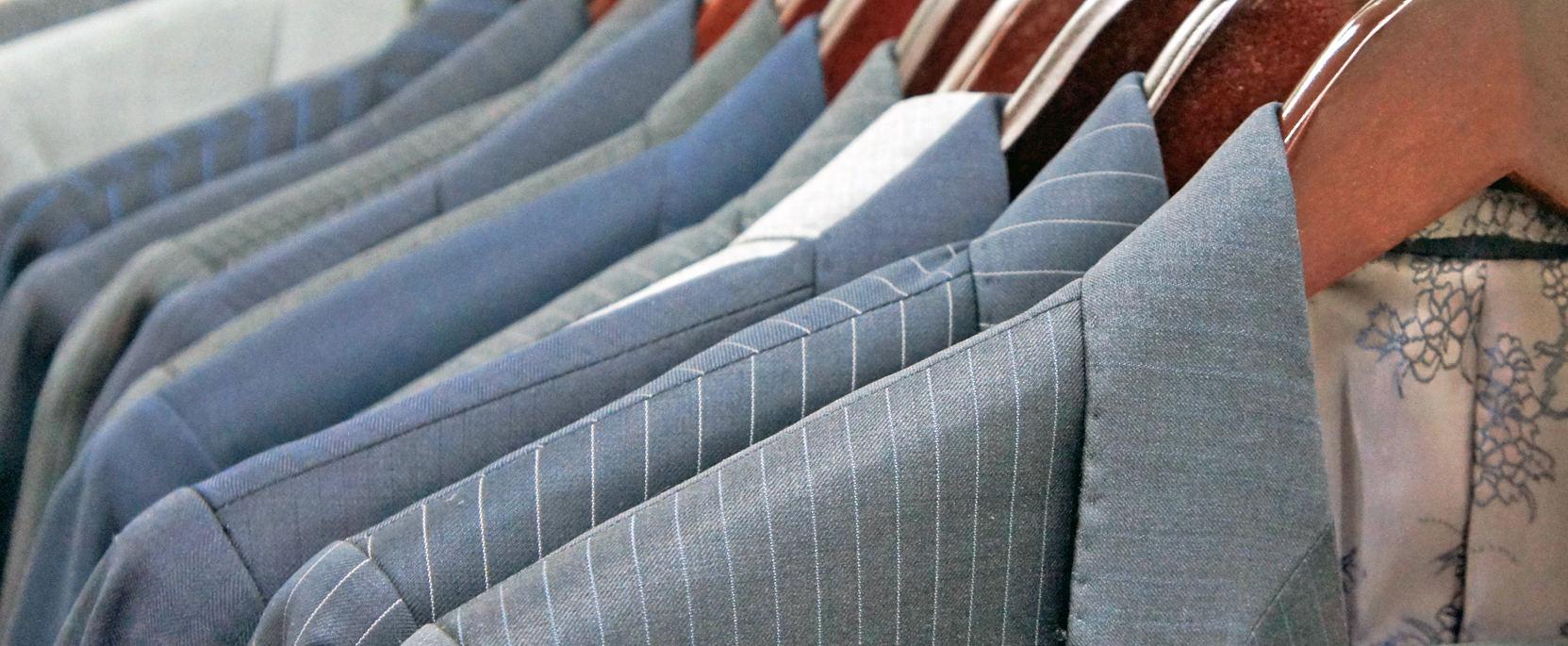My First Exposure to Salesmanship, Branding, Customer Service
& Goal Setting
by Peter Cotton, founder and president of Best Sales Talent, LLC

(This is a personal story that is more than a half of a century old.)
When I reached the age of 13, my Dad wanted me to learn about earning money in a business setting. I had already been earning money from snow shoveling, grass-cutting and fall leaf cleanup for neighbors, but my Dad wanted me to learn other things. More important things. He arranged a job for me where he shopped for men’s clothing.
I started as a stock boy at a place called The House of Doherty in Worcester, MA. I worked there during junior and senior high school on weekends, school vacations, and during my summer breaks. When I was in college, I worked there when I was home from school. I was conscientious and the owner took a liking to me and sort of took me under his wing. He spent many hours telling me about his methods and why he used them at the store, what his business goals were, and how he intended to reach them. My work at The House of Doherty gave me my first exposure to salesmanship, branding, customer service and goal setting. Those things were imprinted on my young mind. What I learned from the owner I later put into practice in my own business many years later and still use them today.
Dan Doherty, now deceased (hereinafter referred to as Dan), was one of two sons of the former Briggs Doherty, the owner of a very unique men’s clothing store in Providence, Rhode Island. The store no longer exists. Briggs Doherty, Jr., Dan’s younger brother, continues to be involved in the men’s clothing business as Briggs & Adams (http://briggsadams.com/ ), but he has moved to the Chicago market. Dan worked at his father’s store while in his teens. His father was a tough task master, very demanding, and he had quite a temper. Dan didn’t go to college, but he “studied” under his father learning about the men’s retail clothing business. What he learned from his father he put to use in his own business endeavor.
In 1952, at the very young age of twenty-one, when his peers were spending their time on their studies, girls and partying (not necessarily in that order), Dan started his own unique retail men’s clothing store in downtown Worcester, MA. Three years later, having reached a level of success, he moved to a larger and more unique address. The new location was a house that he converted into a multi-roomed showroom- thus The House of Doherty. It was at this location that his business flourished.
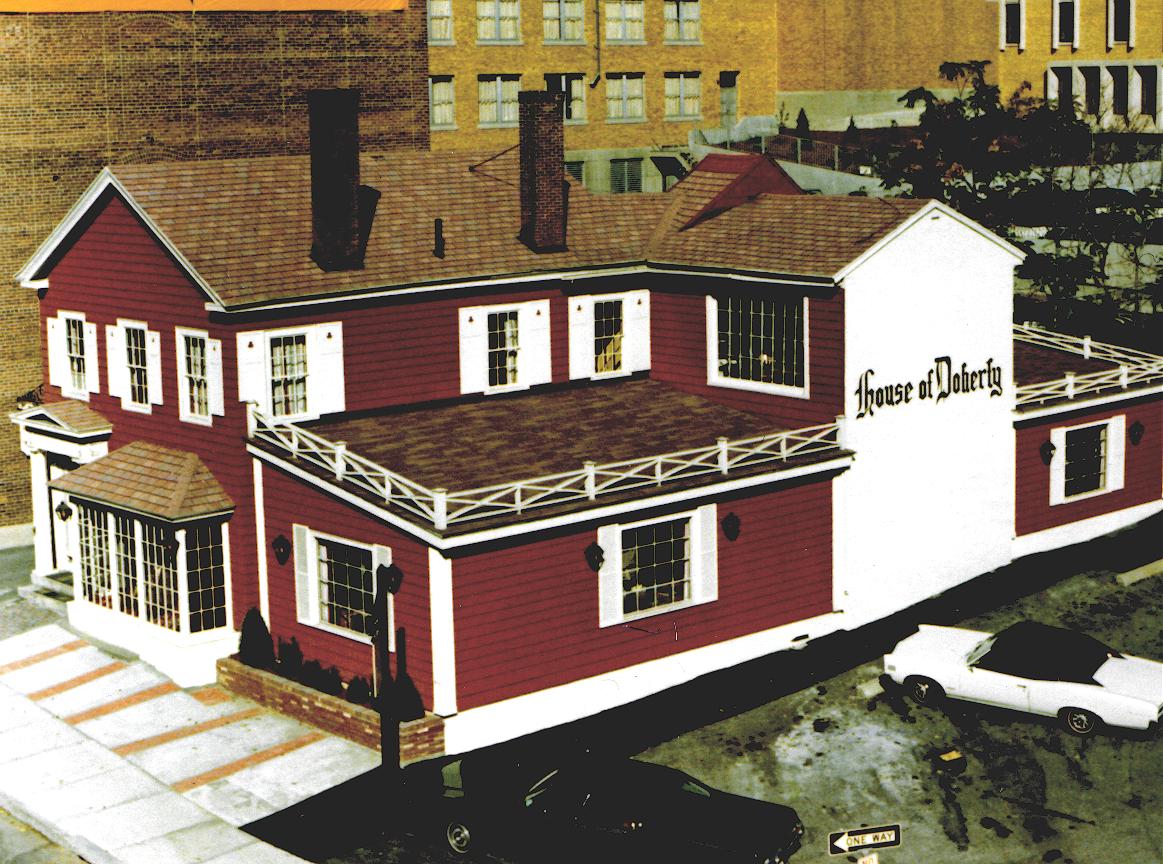
The House of Doherty – Circa 1971
Unlike other retailers, Dan made a concerted effort to have his store not look like any other. He didn’t use the standard, boring racks and shelving found in the typical men’s department of a department store. His place of business had wall-to-wall carpeting, but the carpeting was covered with dozens of beautiful, Persian rugs. There was an eclectic and handsome assortment of antiques and unusual furniture, cleverly employed to display merchandise; leather couches and chairs; coffee tables; business magazines and newspapers (for those who were waiting); end tables with lamps; paintings and lithographs (all with a decidedly up-scaled gentlemen’s taste). Great care was taken to be certain that the environment was tasteful and masculine. The furnishings and decorations created an atmosphere that was luxurious, yet relaxed, making the customer feel that shopping there was a very pleasant experience – an experience like none other.
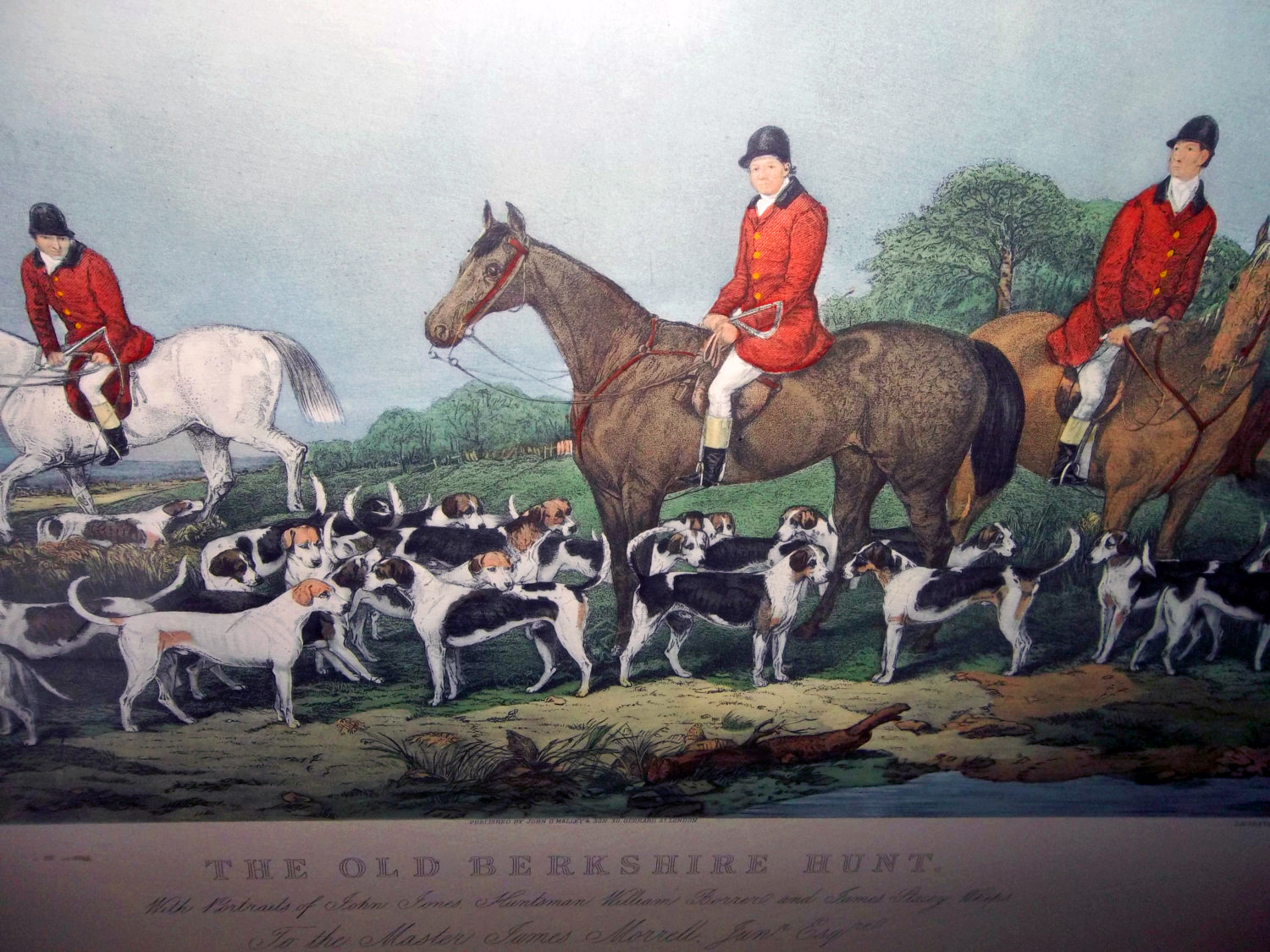
Matching the unparalleled atmosphere, Dan and his sales personnel treated all customers with the utmost respect and professionalism. Many people felt especially important from the treatment they received there. This served the business well with the benefit of many repeat customers, as well as those referred to Dan by the growing numbers of highly satisfied patrons. People were referred to as Mr. (and Mrs., if the spouse accompanied the male customer). Never by their first name. All customers who shopped there were given a great deal of personal attention, whether it was to select a particular necktie or several custom-made suits. If a person purchased a necktie, it never went into a bag. A special red gift box, with the store logo on it, was used. The tie was neatly wrapped in tissue paper and then put into the box and tied with a bow. Suits and sport coats were sent out of the store on wooden hangers, not on thin plastic or flimsy metal. All suits, sport coats, and trousers were placed on these hangers and then into zippered suit bags. Both the bags and hangars were embossed with The House of Doherty logo on them.
Gentlemen who were there to make sizeable purchases were invited to sit in one of the couches in an interior room. A highly attentive stock boy [that would have been me], who was referred to as a porter, would serve these special customers steaming-hot coffee in large, black, ceramic mugs (with The House of Doherty stylized logo prominently displayed on them). Dan would bellow over the intercom: “Peter! Two coffees. One with milk and two sugars. One black.” I would drop whatever I was doing and immediately attend to the coffee. Just as Starbucks does today, I kept watch on how long the pot was on the heating element. If it had been sitting there for more than 30 minutes, I’d make a fresh pot. It was also my job to see to it that ashtrays were always clean, baskets always empty, and merchandise always neatly arranged. A constant task was to sweep the fringe straight on the rugs. Dan hated to see the fringe any way but straight, because it didn’t look neat and organized. Even today, when I see fringe on a rug askew, I am tempted to make it straight. I smile to myself and remember Dan.

The rooms in The House of Doherty were each designated for different types of clothing.
The front room showcased sweaters (cashmere and Shetlands) and a complete wall of hosiery. A side room had two walls of shirts displayed (straight-collared on one side and button-downed on the other). I would arrange them by color and size. For no additional charge, the shirts could be monogrammed while the customer waited. The side room also contained underwear, dress trousers, chinos and corduroys; sport shirts, belts (leather and fancies); neckties, silk squares, suspenders, cummerbunds and formal accessories.
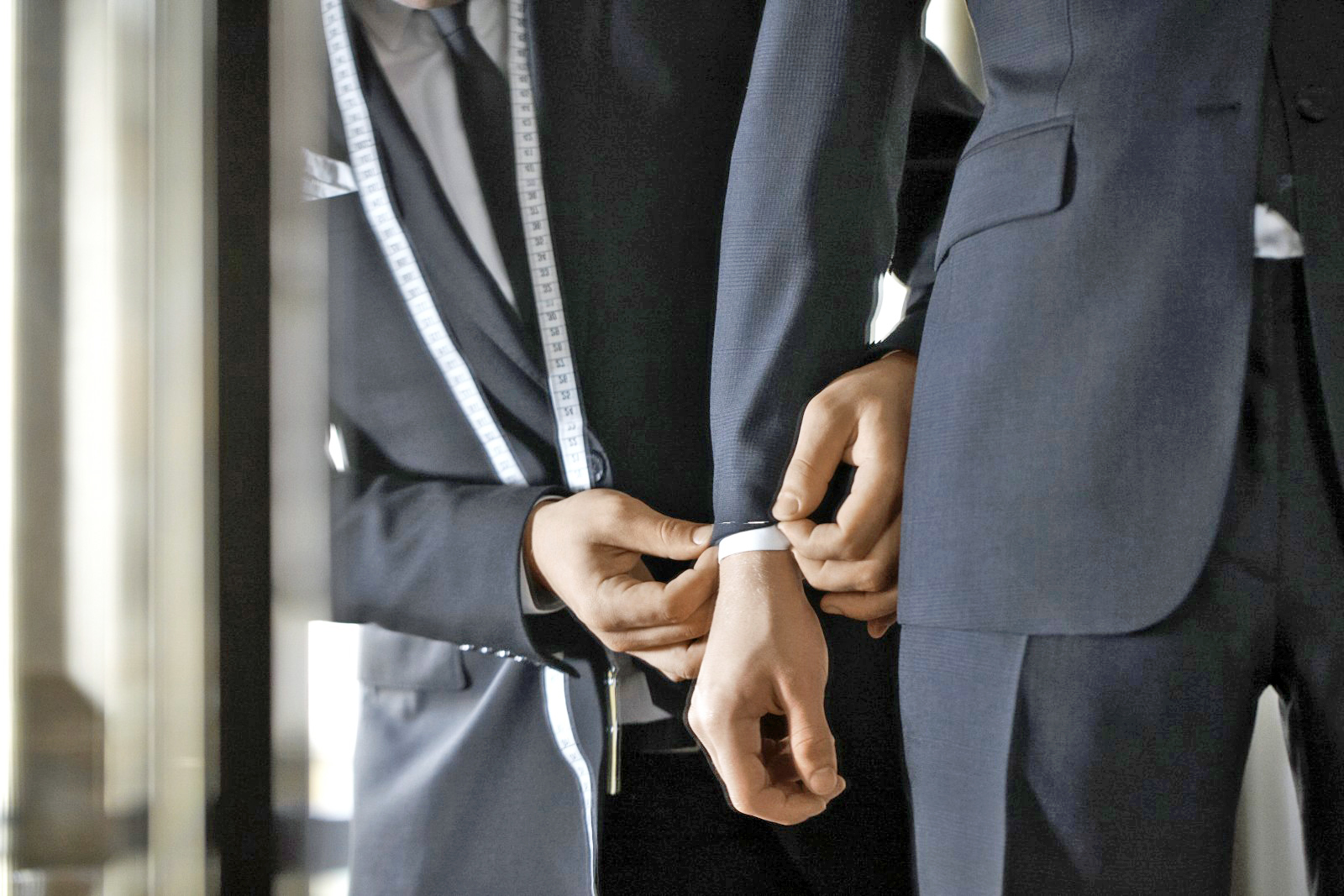
One room was dedicated to sport coats and blazers, while another was known as the custom room. The custom room was where Dan did most of his own personal selling. Here, among the leather couches and coffee tables, customers would drink their coffee as they made their selection of fabrics and linings for a suit or sport coat. These would be tailored for them to their exact specifications. Gentlemen would also be seated here while waiting for their garment to be brought downstairs for a fitting by one of the in-house tailors. The tailors were all highly skilled. They served as walking samples. They never came downstairs to do a fitting unless they were in a Doherty’s suit or sport coat and tie, complete with a colorful silk square in the breast pocket.
A fifth room in The House of Doherty was dedicated to rain coats, top coats, poplin jackets, leather coats and bathrobes, while the sixth was used to display ready-to-wear suits. On the top floor of the store were the stockroom, shipping room, tailor shop and office.

In 1984, in an attempt to stay as a leading edge retailer, Dan brought his wife, Marilynn, down from the office duties she so aptly handled, to run the woman’s clothing department. There, ladies tailored suits, slacks, sport coats and casual sweaters were sold. When gentlemen shopped in the store with their wives, Dan and Marilynn paid them extra attention. Between the two of them they could ring up some significant sales during these husband and wife shopping trips. The wives enjoyed the personalized attention that was given to them just as much as the men.
In the year of their zenith (1988), The House of Doherty employed seventeen people in the store between Dan and his wife, office help, sales personnel, tailors and a full-time and part-time porter. Their sales at that time were approximately $1.75 million. This was accomplished with the average cost of a custom-made suit at $395. By comparison, at today’s prices, even a ready-to-wear suit will cost at least $700. Custom-made suits are far more expensive – well into the thousands.
Dan thought of his store as his platform. His domain. His stage. He considered himself to be an actor on this stage. The role he played was one of a consummate salesman. He sold more custom-made clothing than any of his staff. For a customer to be dealing with the owner was a big attraction of course, but nobody could deny that Dan was a real showman. On a nice day, Dan would encourage his customers to go outside with him to see the real beauty and color of the fabric they had chosen in direct sunlight. He would take yards of the cloth and literally throw it across the hood of his impeccably spotless, late model, XKE Jaguar (later he switched to a Porsche), kept impeccably clean by the porter [me again]. While the customer would stand there, coffee mug in hand, Dan would describe the fabric and how nice it would look made into a particular suit to be worn on the occasion for which it was needed by the customer. Every customer was impressed by the flair by which Dan sold. They would be equally impressed with the car he owned. An expensive, two-seater, convertible sports car sent a message to his customers – that Dan was highly successful. People love to deal with successful people and Dan knew that.


A 1966 Jaguar XKE Convertible – British Racing Car Green, Tan Interior – Just Like Dan’s
Dan and his staff created a very high class selling environment. It significantly raised the customer’s level of consciousness in style and good taste. Dan was carrying out a most important marketing strategy — branding. The House of Doherty brand became synonymous with a certain kind of status. When complimented on how good they looked in a new suit, men would love to show their personally selected colorful silk lining (in so doing, The House of Doherty label would be seen) and the matching colored silk square in the breast pocket. The ensuing conversation would inevitably come around to what a unique shopping experience it is to make purchases there, what a character Dan is, and how catered-to the customer felt. To say the referral business was dramatic would be an understatement. People were curious about shopping there and when they did, they always returned. Dan’s customers referred other people who bought clothing there. The referred customers became champions of The House of Doherty brand and they referred even more customers.
Word traveled fast around town, in neighboring towns, and soon as far as Boston and New York. The House of Doherty was indeed known as a special place for men to go who had good taste in clothing (or who wished to acquire it). Very important gentlemen shopped in Dan’s store. Very well connected gentlemen. Presidents and CEOs, bankers, lawyers, doctors, accountants, even high-level clergymen. Each and every one of them was treated in a most respectful manner. All men enjoyed the idea of going there because shopping in The House of Doherty was a status symbol. Being able to afford such fine clothing meant that the customer was successful – or at least appeared to be successful. As the saying goes: “The clothes make the man.” It was certainly apropos for this group of customers.

As most men do, they talked about their cars. The vehicles they owned were representations of the owner’s success. An extension of their ego. When I turned 16, having just obtained my driver’s license, I was in absolute awe of the types of cars men drove into The House of Doherty parking lot: Ferraris, Lamborghinis, Porsches, Mercedes Benz, Aston Martins, BMWs, and even a Rolls Royce. Every one of them wanted to show off their latest car purchase and for Dan to acknowledge their success. Dan stroked their egos (even if the car was leased and not owned outright) and invited them into his “inner sanctuary” where the men would sit for hours, drink coffee, smoke cigars and talk about politics, business and world affairs. None of them escaped Dan’s ability to steer the conversation to clothing and few ever left the store without making some major purchases.
Success breeds success as they say. Dan used it to his advantage in every possible way. This “rubbing elbows” with the rich and well-connected is what fueled Dan’s own ambition to serve these men. Perhaps he had not attended college like them, but on his stage, in his theater, he was in command of these powerful and influential men. He made it a game to himself to see how much he could sell them. It was not at all unusual for one of his customers to spend several thousand dollars in one visit. To keep track of his success, Dan kept a “Beat Yesterday” book. It compared the day to the same day last week, last month and last year. He was driven by his sales goals for himself and his sales people. There were times when he would run to his calculator by the hour each day to add up sales slips to see how they were progressing with that day’s sales goals. I learned goal setting from Dan. To this day I have a “Beat Yesterday” book that I use in my business.
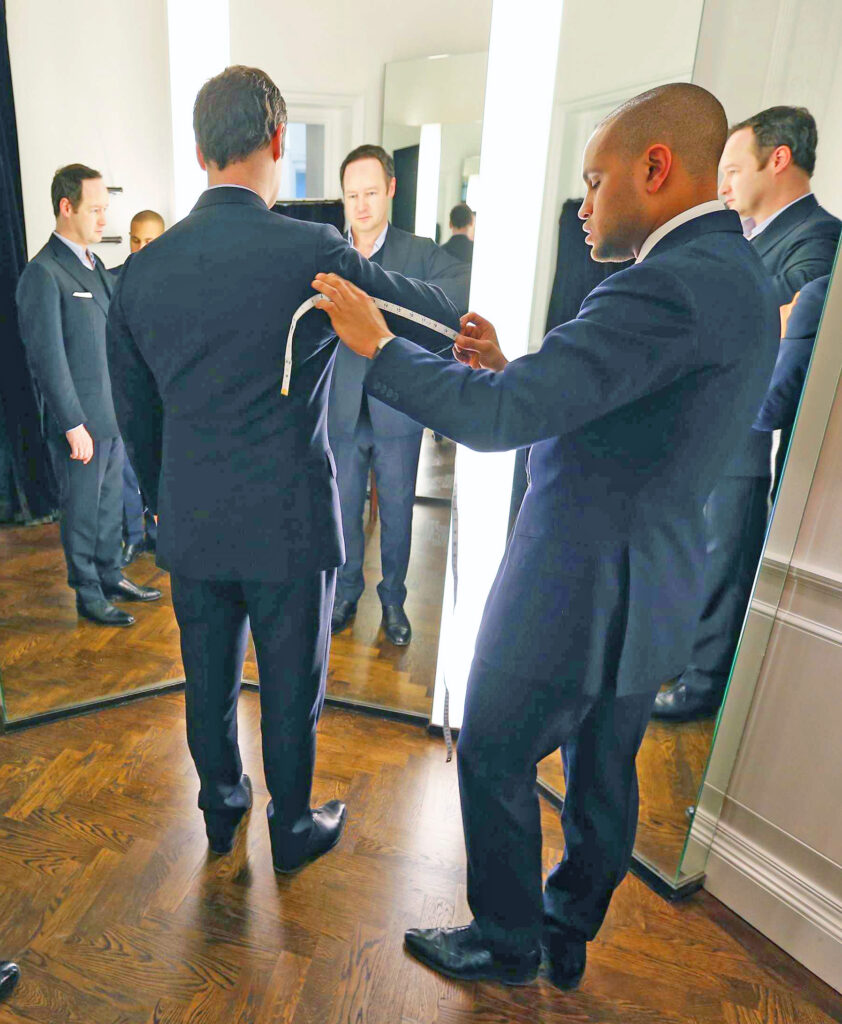
It is interesting to note, however, that the sales personnel at the store were not high-pressure salesmen. In fact, Dan paid them a salary (and a bonus for going over a sales goal) instead of the usual minimum wage draw verses commission, typical for other stores. Dan didn’t want his customers to feel pressured to buy a thing. He used a reverse selling psychology. By making customers entirely comfortable and feeling catered to, they were so relaxed they succumbed to suggestive sales techniques in a very unthreatening way. The salesmen were perceived as fashion consultants. All the customers wanted the status of being served by a House of Doherty sales person. They all wanted to look good, and they all liked being seen and seeing others who were “in the know” who shopped there. They all wanted the status of owning clothing from The House of Doherty. This was a very important aspect of Dan’s “master plan.”
Dan and his staff duly noted interests, likes (and dislikes) of every returning customer. They all knew exactly how to deal with each particular person. Over time, it was very common for these gentlemen to share their news of their business dealings in the community, who they knew, who they were friends with and who they wished they knew. Dan made it a point to know about their business and in very tactful ways would sometimes make introductions of one customer to another if he felt that they would benefit from the mutual contact from a business or professional perspective. He became privy to not only their business dealings and financial issues, but also various aspects of their personal lives. He befriended as many as he could. These friendships led to more business from these customers and of course, they referred others to him as well.
The customers became so well known at the store, so connected to Dan and to other customers, that in a way, it became a “club.” A club of gentlemen. A club of movers and shakers.
There were times when a customer would confide in Dan about a particularly difficult time they were having in business. Dan kept everything confidential. On one occasion a customer admitted to him that if he didn’t come up with $350,000, he was going to lose the building in which his manufacturing business was located. He was terribly concerned that he would have to shut down his business and put people out of work. The customer was apparently having great trouble raising the financing he so badly needed. With the most tactful aplomb, Dan quickly introduced this customer to the president of a local bank who shopped in the store. In a matter of hours, the funds were made available at attractive terms. Needless to say, this customer became eternally thankful. Dan relished doing this for his customers. He loved to put deals together. He made introductions of one customer to another for their mutual benefit quite often. As a result, these gentlemen would continue to shop in his store and they would refer others to The House of Doherty.
Despite his uncanny success at the store, Dan’s business felt the same problems of other retailers of the time, particularly those who experienced the malaise and resulting decay of the downtown Worcester shopping area. He weathered recessions of course, but one recurring problem created serious financial difficulties for him. A real dilemma.
All customers like easy credit, so the easier, or more relaxed, the credit policy Dan made, the more sales there would be for the store. Conversely, a tighter credit policy would lower sales somewhat. To ease credit policy, Dan did such things as increase the credit period from 30 days to 60 days; ease his credit standards so as to offer credit to customers with lower credit scores (who are likely to pay late or sometimes not at all); and use less tough collection methods to avoid offending customers. All of the easing actions tended to increase annual sales.
The easing actions would also increase the receivables collection period. Increasing the time customers had to pay their bill would obviously delay collections. Selling to customers with low credit scores and being less tough on collections would also lead to slower payments, or in some cases, defaults on payments.
Although many of his customers paid for their purchases with cash, Dan allowed a fairly large number of them to charge their purchases to their account. They would be billed monthly for outstanding balances. Like any retail business, Dan had significant fixed overhead and a hefty investment in inventory, not to mention the salaries of his people. When a number of customers were late in making payments on their accounts, it created some real hardships for his business. Late payers were part of doing business, of course, but it became very costly. It was bad enough to have slow payers, but it was worse was when a customer charged a considerable amount of clothing and then, for any number of reasons, never paid for it at all, and was never seen or heard of again. Too many slow or non-payers would bring his business to a halt. In effect, Dan was giving the slow payers interest-free loans equal to the value of the merchandise they had charged. Dan was aggravated by this. He once confided in me that he wasn’t in the clothing business. He said he was in the “interest-free loan business.”
There is a phenomenon that takes place in this purchase-and-delay payment scenario for a specialty retailer. Although a person may have been a frequent customer at the store, when their account grew to a high balance, they tended to be embarrassed about coming back to shop at the store – even if they really needed some clothing. Dan and his office staff would walk a fine line between alienating a customer by tactfully asking to be paid and hurting themselves by allowing the same customer to make additional purchases on his charge. Too many customers like this could spell disaster. Of course there was the added work and expense for the office to keep track of the account, do the paperwork, prepare and mail monthly statements, and make collection calls. Inevitably, too many slow or late paying customers meant that The House of Doherty would have to dip into their line of credit at the bank, just so it could pay its own bills. These line of credit loans would be at the then prevailing interest rate – an added expense for the business.
Therefore, the problem the customer had of meeting his own monthly obligations, for whatever reason, became transferred over to the store and became the problem of The House of Doherty. This was a constant problem until one day Dan came up with a solution.
Dan had a very basic software program in the office that kept track of his customer’s purchases and would generate monthly bills. Dan approached State Street Bank of Boston. He convinced them to make a custom-made credit card, with his store name and logo on it. Mind you, this was decades before retailers all started offering their own branded credit cards. Dan was ahead of the trend. He ended the charge accounts he carried and offered a House of Doherty credit card to his customers. He explained to his customers that the bank would be handling all billing.

The daily sales could be transmitted to the bank using Dan’s software, and the bank would deposit the funds for those sales dollars into Dan’s business account, minus a percentage (the merchant fee) on a daily basis. Since the bank took over the receivables and billing, the customer had the option of paying the full outstanding balance, or paying the minimum payment due indicated on the statement. Paying the minimum due on the statement meant that the customer would pay fairly high interest on the revolving balance, but that was no longer the “problem” for The House of Doherty, since they were not carrying the receivables. Moreover, the possible scenario of alienating the customer was no longer to be an issue, since no more collection letters, calls or in-person requests for payment in the store needed to be made by Dan or his office staff. This was a time and money saving move for Dan’s business and it eliminated a lot of stressful times. Dan removed himself from the “interest-free loan business.”
Dan’s business was to no longer suffer from the monthly financial problem he was having with late paying customers. The members of his “club” would be comfortable in returning to his store, Dan could maintain good relations with his customers, and they would be able to buy their clothing. It was a win-win scenario and everyone was happy. Since The House of Doherty credit card carried the logo of Dan’s business on its face, Dan reinforced his branding strategy once again.

Coupled with Dan’s salesmanship and goal setting attitude, The House of Doherty thrived for many years until a deep recession and a life-threatening illness befell upon Dan, causing him to retreat from his business. There were attempts to keep it going with others in management, but without Dan at the helm, The House of Doherty lost the flair of the owner and it ultimately went out of business. Today, where once a strong and vibrant business stood is now a parking lot for a bank. It was a sad ending to a real great business.
Dan Doherty had a very positive and long-lasting impact on me. What I learned from him about salesmanship, branding, customer service and goal setting I put to good use in my own business since 1977. I think of Dan often and of the special relationship I had with him. I am grateful that my Dad had the foresight to introduce us.

Dan Doherty standing at the entrance to the ready-to-wear sport coat room.

